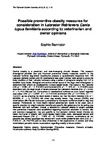Possible preventive obesity measures for consideration in Labrador Retrievers Canis lupus familiaris according to veterinarian and owner opinions
| dc.contributor.author | Bannister, S. | |
| dc.date.accessioned | 2019-05-15T14:52:36Z | |
| dc.date.available | 2019-05-15T14:52:36Z | |
| dc.date.issued | 2013 | |
| dc.identifier.citation |
Bannister, S. (2013) 'Possible preventive obesity measures for consideration in Labrador Retrievers Canis lupus familiaris according to veterinarian and owner opinions', The Plymouth Student Scientist, 6(1), p. 1-15. | en_US |
| dc.identifier.issn | 1754-2383 | |
| dc.identifier.uri | http://hdl.handle.net/10026.1/14005 | |
| dc.description.abstract |
Canine obesity is a persistent and ever-increasing chronic disease. This research investigated possible new and improved preventive obesity measures specific to the Labrador retriever dog breed. Quantitative analysis of questionnaire responses from 128 Labrador retriever owners and 46 veterinarians was used. Owners were asked to score the body condition of their Labrador retrievers using a series of pictograms ranging from 1-5 to establish body levels. Biological and environmental factors of the dogs were investigated to determine their effects on predisposition to body weight levels. The colour of the Labrador (Chi: χ² = 10.964; d.f. = 4; P<0.027) and the breed (Chi: χ² = 11.073; d.f. = 2; P<0.004) were associated with the dogs' levels of obesity whereas the Labrador's field/role (Chi: χ² = 3.240; d.f. = 2; P<0.198) was not. Comparison of veterinarians' opinions on such factors regarded coat colour (Chi: χ² = 1.22581; d.f. = 2; P>0.542) and breed (Chi: χ² = 0.310345; d.f. = 1; P>0.577) as not affecting the dog's levels of obesity, but that the dog's field/role (Chi: χ² = 56.3333; d.f. = 4; P<0.001) did affect dog obesity levels. Dog owners (78.9%) and veterinarians (86.2%) demonstrated a preference for increased nutritional detail on dog food sources. Preferences for more health related advertisement words to be used, use of specific exercise for weight reduction benefits and specific diet guidance after de-sexing was observed from both samples. Overall, a reduction in Labrador obesity is sought: possible new preventive measures were established regarding improved education to owners, diet and exercise management that are specific to the Labrador retriever breed. Owners do relate the matter of obesity with future issues; health risks, costs, decreased welfare and decreased lifespan (Chi: χ² = 17.978; d.f. =6; P<0.006). However, veterinarians do not perceive that owners associate dog obesity with future health problems and costs (Chi: χ² = 3.443; d.f. =6; P>0.752) and so clear differences in the expectations of owners and what veterinarians perceive owners expectations regarding obesity to be are evident. | en_US |
| dc.language.iso | en | en_US |
| dc.publisher | University of Plymouth | |
| dc.rights | Attribution 3.0 United States | * |
| dc.rights.uri | http://creativecommons.org/licenses/by/3.0/us/ | * |
| dc.subject | canine obesity | en_US |
| dc.subject | questionnaire | en_US |
| dc.subject | preventive measures | en_US |
| dc.subject | owner's attitudes | en_US |
| dc.subject | veterinarian opinions | en_US |
| dc.subject | Body Condition Scoring (BCS) | en_US |
| dc.title | Possible preventive obesity measures for consideration in Labrador Retrievers Canis lupus familiaris according to veterinarian and owner opinions | en_US |
| dc.type | Article | |
| plymouth.issue | 1 | |
| plymouth.volume | 6 | |
| plymouth.journal | The Plymouth Student Scientist |



